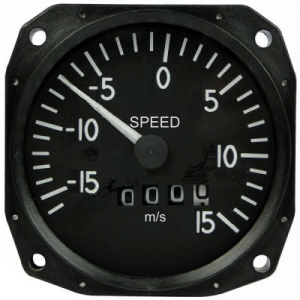 Page 2 Example 1:  We can say that A is greater than B because 7 is greater than -2 or A > B because 7 > -2 We can also say that B is less than A because -2 is less than 7 or B < A because -2 < -7 Hete's another one. You try it:  What can you say anout C and D? (two things): Use > and < signs ... Check your answers by holding the cursor over the box below: Example 2:  E is greater than F
E is greater than F4 is greater than -1 E > F F is less than E -1 is less than 4 F < E You try this one:  Use a > or < sign:
Use a > or < sign:G H H G Answers: Example 3:  In the picture at the right, sea level is at height 0 km. That's where the ship is.
In the picture at the right, sea level is at height 0 km. That's where the ship is.
The plane is at height 5 km. The submarine is at depth -2 km. How many kilometres above the sub is the plane? Answer: Example 4:  The meter at the right measures a boat's speed in km/h.
The meter at the right measures a boat's speed in km/h.It started by backing up at -7 km/h Its speed was -7 km/h Then it moved forward at a speed of 2 km/h. By how many km/h did the speed increase? Answer: Example 5: 

Here is a thermometer. In the evening on the left, the temperature is shown. At the right you can see the temperature the next morning. By how many degrees did the temperature fall? Answer: Example 6: Putting Integers in Order Rearrange the list of integers below by dragging them into order, smallest to largest. Then check your answer by holding the cursor over the blank box at the right.
Find out how the set of Integers fits into all the other sets of numbers.
|





